Fire Ants and Native Plants
Solenopsis invicta
Formicidae
Today John and George skipped northward to St. Lucie County to wade through Paleo Hammock, a beautiful site with Water Hickories, meadows of weird Garlic Weed, ancient Native American mounds, distant thunder, and water up to your ankles.
There are so many lovely beautiful species there, why in the world write about the most detested species on Earth…the imported invasive Fire Ant!? Boo!
If you can rise above old grudges, however, they are mighty interesting. John had fun stirring them up with a stick. POKE HERE Fire ants and their associates extend last week’s theme of unexpected twists and turns in why plants (and ants, and sucking insects) wind up where they do.
Often fire ant1 mounds are centered conspicuously around the bases of fibrous-rooted plants, frequently Grasses. Of course this raises a chicken and egg question: which comes first, the ant mound or the Grass? Does the ant plant the Grass in the ant mound, or does the ant colony build its mound around the preexisting Grass clump?
Speculative answer: The Grass probably comes first, as we see it, because the clump is “always” rooted dead-center in the mound. If the mound came first, we’d expect the grasses to sprout at different points on the mound, not necessarily the bulls eye. But if the mound is built around the established Grass, the clump is “ground zero,” and its radiating brush of roots may help define the mound dimensions. (Maybe)
Let’s pretend Grass-came-first is correct, then why would Fire Ants build around it? (Related question: Why are they such turf pests?)
Here are possible answers with mixed fact and speculation:
1. NEST REINFORCEMENT. The Grass could provide ant nest-reinforcement against wind and water, maybe even a little shade. And more interestingly…
2. FOOD. Fire ants are omnivores. Although usually thought of as predators, they need plant-based carbs, including roots (fact), and (speculation) possibly root exudates. So maybe the Grass roots are a salad bar right in the nest. And the plot thickens…
3.THIRD PARTIES. Fire ants tend tiny sucking insects underground or at the root crown as sources of sugary honeydew (fact). Turf managers are aware of associations between fire ants and subterranean aphids on grass roots. The honey-makers include mealybugs and root-dwelling aphids. These tiny root-hugging micro-cows seem to have much to do with the fire ant- plant friendship. Read on…
A broad 1994 study of mealybugs showed the little suckers to pester 250 families of plants. The most-infested family was—and this may surprise you—the Grass Family, with mealybugs bugging 585 Grass species. If I were a fire ant trolling for a mealybug, I’d start with a Grass. And even more to the point…(the point being involvement of sucking insects)…
In 2011 biologist Shawn Wilder and collaborators in Arizona showed honeydew from diverse sucking insects to boost fire ant colony development, evidently enhancing their competitive ability and fostering their geographic spread. And more specifically…
In 2012 and 2013 Biologist Aiming Zhou and collaborators documented a win-win relationship between fire ants and an invasive crop-pest mealybug named interestingly, Phenacoccus solenopsis. It’s a love triangle. The ants get sweet tasty honeydew from the mealybugs and possibly additional root benefits from the plants. The mealybugs get a safe home, and are ant-tended and spread around. And the plants enjoy protection from the most ill-tempered creatures on earth, as well as possible soil enhancements. The relationship helps the fire ants drive away native ants. The Phenacoccus solenopsis mealybug is an infamous cotton pest, and it occurs in Florida, living on roots and also above the soil line on many host plants, including Grasses.
So what exactly is going on here and now with fire ants, Grass plants, and probably sucking insects is not clear. What a fertile area for research for a motivated student with tall waders and an EpiPen. There aren’t many competing researchers, and who needs to travel to exotic field sites when compelling ecological relationships are playing out right in the back yard?
Photos below added Aug. 25 (taken 8/24) a few weeks after the blog was posted. These photos show the bases of sterile grass plants (Eustachys petraea?) in the center of an ant mound. The ants were small, reddish, and belligerent. Probably Fire Ants but no certainty. The grass bases are infested with mealy bugs. (On a nearby Eragrostis spectabilis centered in an ant mound there were scale insects in the same position.)
—————————————
1We’re no ant experts. Perhaps we see also mounds from other small reddish grumpy ant species. But if it walks like a Fire Ant, quacks like a Fire Ant, and burns ankles like a Fire Ant we’re calling the critters fire ants. Do not trust us.
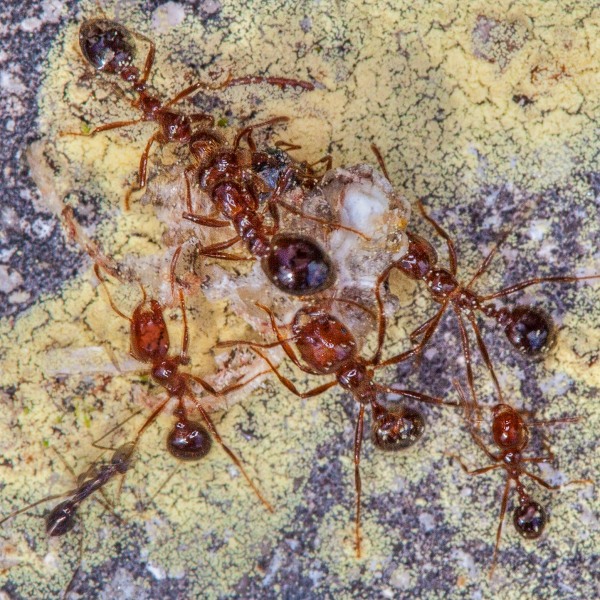
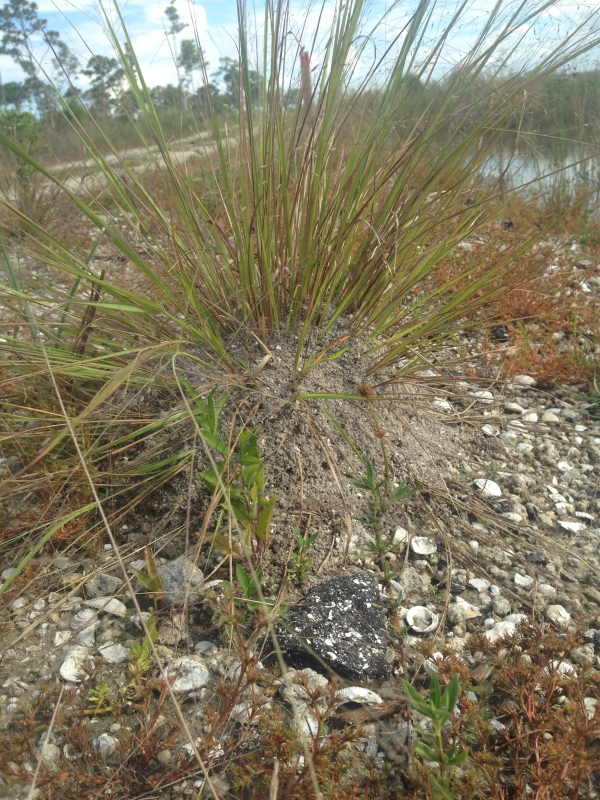
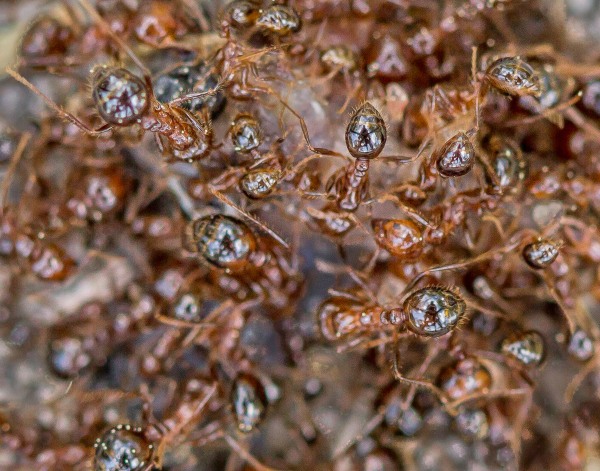
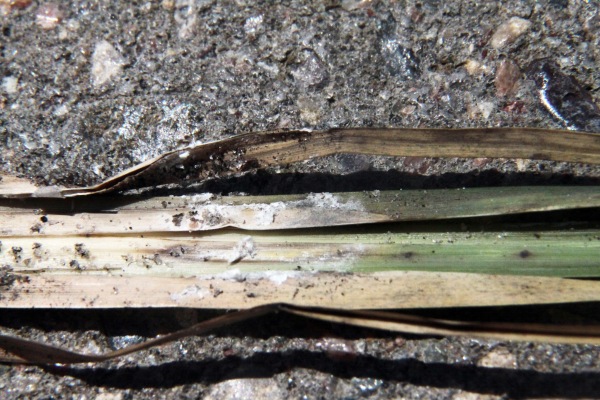
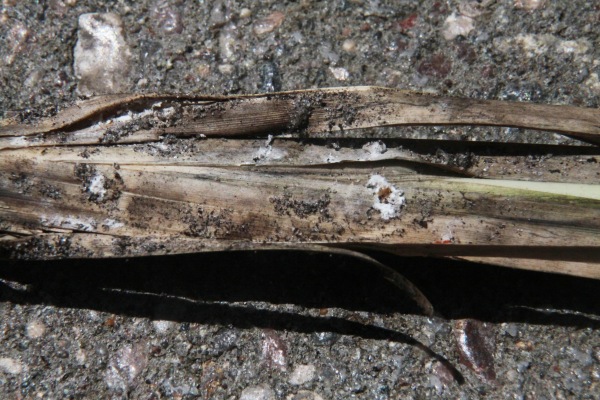
Uncle Tree
August 2, 2014 at 8:12 am
How do you make someone smile, but then give them the creeps at the same time?
Is it the science of humor? Or the humor of science?
Probably both, as you’ve proven here, George and John.
Makes for a fun and interesting read. Good show! 🙂
George Rogers
August 2, 2014 at 8:36 pm
Uncle Tree, I think you know how to make someone smile and give them the creeps. Thanks for getting a word in—not much action on the ol’ blog this week.
Mary Hart
August 6, 2014 at 4:40 am
Fire ants appear to have same attribute as UK woodland ants – close encounters not comfortable!!
George Rogers
August 6, 2014 at 7:45 am
Yes, you know all my life I’ve sort of dreaded any bites but never suffered many really, until fire ants. Ouch! I love it when I’m standing in front of a group of students yapping away and a hand goes up. Yes? “You’re standing on a fire ant nest.” About 10 seconds later you have to pretend it doesn’t hurt.
Steve
August 17, 2014 at 5:37 pm
I’ve been to that Paleo Hammocks natural area, it is a very cool funky site with lots of evidence for aboriginal activity, and some surprising oddball plants (like Pisonia aculeata). I’ve noticed that fire ants especially love Sporobolus indicus (although the photo you have up there is seems to be an Eragrostis), perhaps it is a favorite of mealy bugs. Having spent my whole life in South Florida, I’ve noticed a decline in fire ants in my neck of the woods (thank goodness), they were the bane of my lawn playing existence.
George Rogers
August 17, 2014 at 8:13 pm
Yea, they do seem to have declined a bit. Knock on wood. Paleo was a lot of fun, but the day were there the trails were shin deep in water, and those mosquitoes we never encounter were thirsty. Too bad I have to go back to work tomorrow, or I’d start a study on “fire ant species preference.” Must agree about the Sporobolus, and they do seem to have some fondness for Eragrostis spectabilis. Couldn’t say if they like the grass species, or if the grasses and ants favor similar habitats. Either way, they do find each other. One of these days with big rubber gloves and big rubber boots I’m going to dig up a grass-ant nest combo and look for underground cooties on the roots.